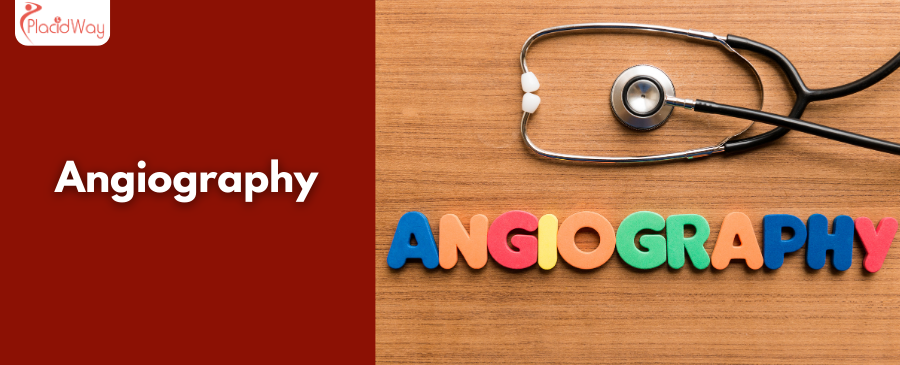
Angiography Abroad: Uncovering Vascular Health with Advanced Diagnostics
Navigating concerns about your cardiovascular health can be daunting. You might be experiencing unfamiliar chest pains, persistent leg discomfort, or warning signs that suggest an issue with your blood vessels. When these symptoms arise, understanding the health of your arteries and veins becomes paramount. That's where angiography comes comes in—a vital diagnostic tool that acts like a detailed roadmap, revealing the intricate pathways of your circulatory system.
Angiography is a specialized medical imaging technique used to visualize the inside of blood vessels and organs of the body, particularly the arteries, veins, and heart chambers. It involves injecting a contrast dye into the bloodstream and then taking X-ray images (or other imaging modalities like CT or MRI) to highlight any blockages, narrowing, or other abnormalities that might be impacting blood flow. This procedure is crucial for diagnosing conditions such as coronary artery disease, peripheral artery disease, aneurysms, and blood clots, which are often searched for online as "heart artery blockage symptoms" or "what causes poor circulation."
For many, the need for angiography comes with questions about cost, waiting times, and access to advanced care. This is where medical tourism offers a compelling solution. Traveling abroad for an angiography can provide access to high-quality, internationally accredited medical facilities, often at a significantly lower cost and with shorter waiting periods than in your home country. Whether you're seeking to confirm a diagnosis, prepare for an intervention, or simply understand your vascular health better, exploring angiography options globally can open doors to excellent care.
In this guide, we'll delve into everything you need to know about angiography, from recognizing the symptoms that might prompt the procedure to understanding the different types, recovery expectations, and crucially, how medical tourism can simplify and enhance your treatment journey. Let PlacidWay help you discover how you can pursue world-class vascular diagnostics and achieve peace of mind.
What are the symptoms that might suggest a need for Angiography?
Recognizing the signs that your blood vessels might not be functioning optimally is the first step towards timely diagnosis and treatment. Many people search for "heart artery blockage symptoms" or "signs of poor circulation." Angiography is often recommended when symptoms indicate a potential issue with blood flow to vital organs. These symptoms can vary widely depending on which part of the body is affected:
- Chest Pain (Angina): A common symptom of coronary artery disease, often felt as pressure, tightness, or aching in the chest, sometimes radiating to the arm, neck, jaw, or back.
- Shortness of Breath: Especially during exertion, this can indicate that the heart isn't receiving enough oxygen-rich blood due to blocked arteries.
- Leg Pain or Cramping (Claudication): Pain in the legs, hips, or buttocks during walking or exercise that subsides with rest, a classic sign of peripheral artery disease (PAD) caused by narrowed blood vessels in the limbs.
- Numbness or Weakness: In the face, arm, or leg, particularly on one side of the body, potentially indicating a mini-stroke (TIA) or stroke due to blockages in brain-supplying arteries.
- Vision Changes or Dizziness: Sudden loss of vision, blurred vision, or severe dizziness can also point to cerebrovascular issues.
- Unexplained Kidney Failure: Blockages in renal arteries can lead to high blood pressure and impaired kidney function.
- Coldness or Color Changes in Limbs: Particularly in the feet or hands, indicating severe reduction in blood flow.
If you or a loved one are experiencing any of these persistent or worsening symptoms, it’s crucial to consult a medical professional. An angiography might be the next step to precisely identify the underlying problem.
What causes blood vessel problems requiring Angiography?
Many factors contribute to the development of blood vessel problems. Understanding these "causes of blocked arteries" or "what damages blood vessels" can help in prevention and early intervention:
- Atherosclerosis: This is the most common cause, a condition where plaque (fats, cholesterol, calcium, and other substances) builds up inside the arteries, narrowing them and hardening their walls. This can restrict blood flow to organs and tissues.
- High Blood Pressure (Hypertension): Sustained high pressure damages artery walls, making them more susceptible to plaque buildup and weakening, potentially leading to aneurysms.
- High Cholesterol: Elevated levels of LDL ("bad") cholesterol contribute directly to plaque formation in atherosclerosis.
- Diabetes: High blood sugar levels can damage blood vessels over time, making them more prone to narrowing and hardening.
- Smoking: Nicotine and other chemicals in tobacco smoke severely damage blood vessel linings, accelerating atherosclerosis and increasing the risk of clots.
- Obesity and Lack of Physical Activity: These factors contribute to high blood pressure, diabetes, and high cholesterol, all risk factors for vascular disease.
- Family History: A genetic predisposition can increase your risk of developing certain vascular conditions.
- Age: The risk of atherosclerosis and other vascular problems increases with age.
- Aneurysms: Weak spots in artery walls can bulge outwards, forming aneurysms, which angiography can detect before they rupture.
- Blood Clots: Can form in arteries or veins, obstructing blood flow.
Many of these causes are lifestyle-related, highlighting the importance of preventative measures, but when problems arise, angiography provides clarity on the extent and nature of the damage.
What are the different types of Angiography?
Angiography is not a single procedure but a category of imaging techniques, each tailored to visualize specific parts of the vascular system. When patients search for "types of angiograms" or "what is an angiogram used for," they're often referring to these distinct variations:
- Coronary Angiography: This is the most common type, focusing on the arteries supplying blood to the heart. It's used to detect blockages or narrowing in the coronary arteries, often in patients with chest pain or after a heart attack.
- Cerebral Angiography: Visualizes blood vessels in the brain and neck, used to detect aneurysms, blockages, or malformations that can lead to strokes or hemorrhages.
- Peripheral Angiography: Examines blood vessels in the arms, legs, or other parts of the body, typically to diagnose peripheral artery disease (PAD) and identify blockages affecting the limbs.
- Renal Angiography: Focuses on the arteries supplying the kidneys, often used to investigate causes of high blood pressure or kidney dysfunction.
- CT Angiography (CTA): A less invasive alternative that uses a CT scanner and intravenous contrast dye to create detailed 3D images of blood vessels. It’s quicker and doesn't involve a catheter insertion into an artery.
- MR Angiography (MRA): Utilizes MRI technology with or without contrast dye to produce images of blood vessels. Like CTA, it's non-invasive and avoids radiation exposure, making it suitable for specific patient groups.
The choice of angiography depends on the suspected condition and the specific blood vessels needing examination. Your doctor will recommend the most appropriate type based on your symptoms and medical history.
Who is eligible for an Angiography?
Not everyone needs an angiography. The decision to perform one is carefully made by a medical team based on a patient's symptoms, medical history, and the results of preliminary tests. People often search for "who needs an angiogram" or "when is angiography recommended."
You might be considered eligible if you:
- Exhibit Symptoms of Vascular Disease: Such as persistent chest pain, shortness of breath, unexplained leg pain, or signs of stroke.
- Have Abnormal Results from Non-Invasive Tests: Like an ECG (electrocardiogram), stress test, or ultrasound that suggest blood vessel blockages.
- Are Preparing for Certain Procedures: Sometimes angiography is done before surgery to map out blood vessels.
- Have a History of Heart Attack or Stroke: To identify the extent of damage and risk for future events.
- Are at High Risk for Vascular Disease: Due to conditions like diabetes, severe hypertension, or very high cholesterol, especially if symptoms are present.
However, there are also factors that might make angiography less suitable or require special precautions:
- Kidney Impairment: The contrast dye used can sometimes affect kidney function.
- Allergies: To iodine or other components of the contrast dye.
- Severe Bleeding Disorders: As the procedure involves puncturing a blood vessel.
- Pregnancy: Due to radiation exposure, though alternatives like MRA may be considered.
Before any angiography, your doctor will conduct a thorough evaluation, including blood tests to check kidney function and discuss your full medical history and allergies.
What is the recovery time and what can I expect after Angiography?
Understanding "angiogram recovery time" or "what to expect after angiography" helps manage expectations and ensures a smooth post-procedure period. Recovery varies slightly depending on whether the angiography was purely diagnostic or if an intervention (like angioplasty and stenting) was performed simultaneously.
Immediate Post-Procedure:
- Bed Rest: You will typically need to lie flat for several hours after the procedure to prevent bleeding at the catheter insertion site (usually the wrist or groin).
- Monitoring: Nurses will frequently check your vital signs, the insertion site for bleeding or swelling, and the pulse in the limb where the catheter was inserted.
- Hydration: You'll be encouraged to drink plenty of fluids to help flush the contrast dye out of your system.
- Discomfort: Mild pain or bruising at the insertion site is common. Over-the-counter pain relievers can usually manage this.
Going Home:
- Diagnostic Angiography: Most patients go home the same day after a few hours of observation. You’ll need someone to drive you.
- Interventional Angiography: If a stent or angioplasty was performed, you might stay overnight for further observation.
Activity Restrictions (usually for 1-2 days):
- Avoid heavy lifting, strenuous exercise, or activities that put pressure on the insertion site.
- Keep the insertion site clean and dry. Avoid baths, hot tubs, or swimming. Showers are usually permitted after 24 hours.
- You might notice a small bruise or lump at the site, which is normal and usually resolves within a few weeks.
Always follow your doctor's specific instructions for wound care, medication, and activity. If you notice severe pain, swelling, fever, or bleeding from the insertion site, seek immediate medical attention.
What are the risks and potential side effects of Angiography?
Like any medical procedure, angiography carries some potential risks and side effects, though serious complications are rare. Patients often search for "angiogram risks" or "is an angiogram dangerous." Your medical team will discuss these thoroughly before the procedure:
- Bleeding or Bruising: At the catheter insertion site (groin or wrist) is the most common complication. This is usually minor but can sometimes be more significant.
- Infection: At the insertion site, though sterile techniques are used to minimize this risk.
- Allergic Reaction to Contrast Dye: Symptoms can range from mild (rash, itching) to severe (difficulty breathing, anaphylaxis). It's crucial to inform your doctor of any allergies, especially to iodine.
- Kidney Damage: The contrast dye can sometimes temporarily affect kidney function, especially in individuals with pre-existing kidney disease. This risk is minimized by hydrating well and sometimes with specific medications.
- Blood Clots: Can form at the catheter tip or insertion site, potentially leading to blockages.
- Damage to Blood Vessels: Rarely, the catheter can damage the artery wall, requiring repair.
- Radiation Exposure: While the amount of radiation is relatively low, it is a factor to consider, especially for pregnant individuals or those undergoing multiple procedures.
- Arrhythmia: Irregular heartbeats can occur during the procedure, usually temporary.
- Stroke or Heart Attack: These are very rare but serious complications, especially if a plaque is dislodged or a severe spasm occurs in a coronary artery.
Your healthcare team will take all necessary precautions to minimize these risks and will monitor you closely during and after the procedure.
How much does Angiography cost worldwide?
The cost of angiography can be a significant factor in a patient's decision-making, particularly in countries with high healthcare expenses. Many people search for "angiogram cost" or "cost of heart blockage test." Medical tourism offers a viable solution for those seeking more affordable options without compromising quality. Here’s a general comparison of angiography costs (diagnostic, without intervention) in various countries:
| Country | Estimated Cost (USD) | Why Consider for Angiography |
|---|---|---|
| USA | $5,000 - $20,000+ | High technology, advanced research, but very high costs often not covered fully by insurance. |
| Western Europe (e.g., UK, Germany) | $4,000 - $15,000 | Excellent medical standards, but can still be expensive or have longer wait times for non-urgent cases. |
| India | $1,000 - $3,000 | Very cost-effective, highly skilled doctors, world-class accredited hospitals, advanced technology, minimal wait times. |
| Mexico | $1,500 - $4,000 | Proximity for North American patients, quality facilities, good value for money. |
| Thailand | $1,800 - $4,500 | Known for excellent patient experience, modern facilities, highly trained medical staff, and attractive tourism. |
| Turkey | $1,200 - $3,500 | Affordable, numerous internationally accredited hospitals, strong medical infrastructure, popular for European patients. |
Note: These are estimated costs and can vary based on the specific type of angiography, hospital, doctor's fees, and whether it includes consultation, pre-tests, or post-procedure care. Interventional procedures (e.g., angioplasty with stenting) performed during the same session will incur additional costs.
Why consider Angiography abroad?
For many patients, the decision to undergo angiography abroad is driven by compelling advantages that extend beyond just the procedure itself. Common searches include "medical tourism for heart procedures" or "affordable heart diagnostic abroad."
- Significant Cost Savings: As seen in the cost comparison, the price difference can be substantial, making life-saving diagnostics accessible to those who might otherwise struggle to afford it.
- Reduced Wait Times: In many countries, public healthcare systems have long waiting lists for diagnostic procedures. Traveling abroad can mean getting crucial imaging done much faster, potentially preventing conditions from worsening.
- Access to Specialized Expertise and Technology: Top medical tourism destinations boast internationally trained specialists and state-of-the-art medical technology, often at par with or exceeding standards in Western countries.
- High-Quality Care and International Accreditation: Many international hospitals catering to medical tourists are accredited by globally recognized organizations like Joint Commission International (JCI), ensuring adherence to stringent quality and safety standards.
- Patient-Centric Experience: Hospitals often provide dedicated international patient services, including language support, concierge services, and assistance with travel and accommodation, making the process smoother and less stressful.
- Privacy and Anonymity: Some patients prefer the discretion that comes with seeking medical treatment away from home.
Choosing to go abroad for an angiography isn't just about the procedure; it's about accessing comprehensive, affordable, and timely care in a supportive environment.
Which countries offer the best value for Angiography?
When searching for "best hospitals for angiography abroad" or "cheapest countries for heart tests," several nations consistently rise to the top due to their balance of cost, quality, and patient services:
- India: A leader in medical tourism, offering world-class cardiac care at a fraction of Western costs. Hospitals are often JCI-accredited, with English-speaking doctors and staff.
- Turkey: An increasingly popular destination, especially for European and Middle Eastern patients. It boasts numerous modern hospitals, highly qualified specialists, and competitive pricing.
- Thailand: Known for its luxurious private hospitals, exceptional patient care, and English-speaking medical professionals. It's a prime destination for combining medical treatment with recovery in a beautiful setting.
- Mexico: Especially convenient for patients from North America, offering quality care and proximity. Hospitals in cities like Tijuana, Cancun, and Monterrey are equipped with modern technology and experienced cardiologists.
- Malaysia and Singapore: Offer high-standard care, though sometimes at a slightly higher price point than India or Thailand. They are renowned for their strict regulatory frameworks and excellent medical outcomes.
These countries not only provide cost advantages but also ensure that patients receive care from highly trained medical professionals in facilities equipped with the latest diagnostic technology.
What to expect when traveling for Angiography abroad?
Traveling for a medical procedure, even a relatively minor one like a diagnostic angiography, requires careful planning. PlacidWay helps simplify this process, guiding you through "medical travel planning for heart procedures." Here’s a general overview of what to expect:
- Initial Inquiry and Consultation: You'll typically start by contacting a medical tourism facilitator like PlacidWay. You'll share your medical reports, symptoms, and questions.
- Treatment Plan and Quote: Based on your information, the facilitator will connect you with suitable clinics and doctors, providing detailed treatment plans, estimated costs, and doctor profiles.
- Visa and Travel Arrangements: Once you choose a clinic, you'll need to arrange your visa (if required), flights, and accommodation. Many clinics offer assistance with these logistics, or your facilitator can help.
- Pre-Departure Preparations: Gather all necessary medical documents, including test results and doctor's notes. Inform your home doctor about your plans.
- Arrival and Pre-Procedure Appointments: Upon arrival, you’ll typically have a thorough consultation with the cardiologist, undergo any necessary pre-procedure tests (blood work, ECG), and have an opportunity to ask final questions.
- The Angiography Procedure: The procedure itself will take place as planned, usually lasting less than an hour for diagnostic purposes.
- Recovery and Post-Procedure Care: After angiography, you'll enter the recovery phase, as described earlier. You'll receive discharge instructions and any necessary medications.
- Follow-up and Return Home: Most diagnostic angiographies allow for relatively quick return travel. Ensure you have clear instructions for post-procedure care and any necessary follow-up appointments. Many international hospitals provide digital records and remote follow-up options.
Throughout this journey, reputable medical tourism facilitators act as your advocate, ensuring clear communication, transparent pricing, and a smooth experience.
How to ensure safety and quality abroad?
Ensuring safety and quality is paramount when seeking medical care abroad. Patients frequently search for "safe medical travel for heart conditions" or "how to choose an overseas hospital." Here’s how you can minimize risks:
- Choose Accredited Facilities: Look for hospitals with international accreditations such as Joint Commission International (JCI), DNV GL, or ISQua. These accreditations signify adherence to global standards of patient safety and quality.
- Verify Doctor Credentials: Research the experience, qualifications, and specialty board certifications of the cardiologists and interventional radiologists who will perform your angiography. Many leading international doctors have trained in Western countries.
- Read Patient Reviews and Testimonials: Look for independent reviews and success stories from previous international patients.
- Ensure Clear Communication: The hospital should offer excellent language support (e.g., English-speaking staff, translators) to ensure you fully understand your diagnosis, treatment plan, and any risks.
- Understand the Full Cost: Get a detailed breakdown of all anticipated costs, including pre-tests, the procedure, hospital stay, medications, and follow-up appointments, to avoid hidden fees.
- Involve a Trusted Facilitator: Companies like PlacidWay specialize in vetting hospitals and doctors, providing transparent information, and assisting with all aspects of your medical journey, acting as a crucial layer of assurance.
- Have a Contingency Plan: Understand what happens if complications arise, including insurance coverage and extended stay options.
By taking these steps, you can confidently choose a high-quality, safe, and effective angiography experience abroad.
What are patient success stories from abroad?
Thousands of patients every year successfully undergo diagnostic and interventional procedures, including angiography, in medical tourism destinations. These "medical tourism success stories for heart care" often highlight several key benefits:
- Cost-Effectiveness without Compromise: Patients frequently share how they received the exact same, or even superior, diagnostic services compared to what was available at home, but at a fraction of the price. This financial relief often allows them to proceed with necessary follow-up treatments, which might have been otherwise delayed due to cost.
- Rapid Access to Critical Diagnostics: Many success stories revolve around patients who were facing long wait times in their home countries, only to find immediate availability and prompt diagnosis abroad. This quick access is crucial, especially for conditions where early detection can significantly impact prognosis.
- High-Quality Care and Personalized Attention: Patients consistently praise the level of personal attention, advanced technology, and expertise of the medical teams abroad. They often describe a comprehensive and empathetic approach, where doctors take the time to explain every detail and address all concerns.
- Seamless Experience: With the help of medical tourism facilitators and dedicated international patient departments, many patients report a smooth and stress-free journey, from initial inquiry to post-procedure follow-up. This support allows them to focus solely on their health.
These positive experiences underscore the growing reliability and appeal of medical tourism for procedures like angiography, empowering patients to take control of their health without financial or logistical burdens.
Take the Next Step with PlacidWay
Ready to explore treatment options abroad? Discover top clinics, compare prices, and get a free quote tailored to your needs with PlacidWay.
Heart Surgery Abroad, Cardiac Care Abroad










Share this listing